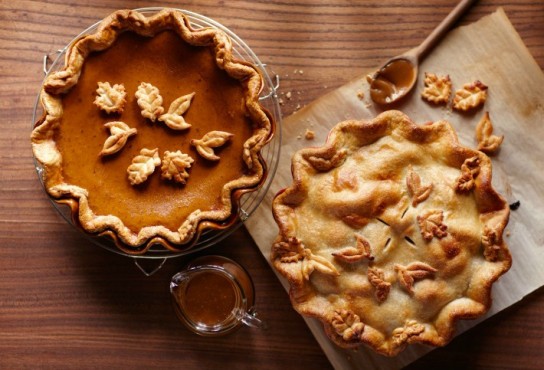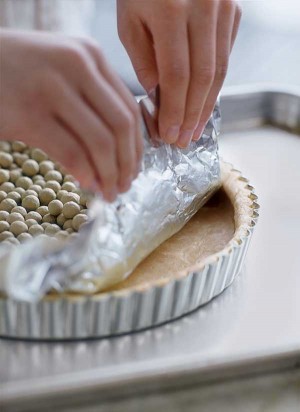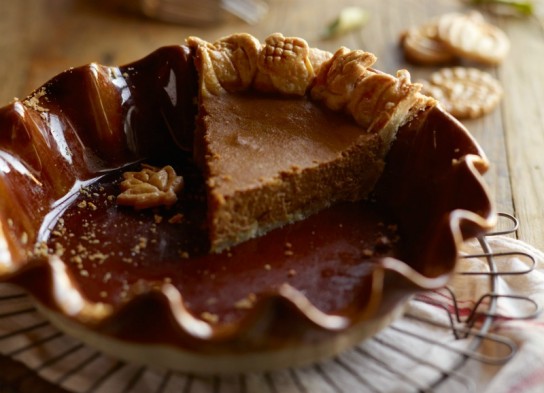 Pies don’t always turn out how you expect them to, but you can handle any last-minute Thanksgiving dessert surprises with this guide. From a crumbly crust to a runny filling, learn how to fix some of the most common pie issues — and how to avoid them next time around.
Pies don’t always turn out how you expect them to, but you can handle any last-minute Thanksgiving dessert surprises with this guide. From a crumbly crust to a runny filling, learn how to fix some of the most common pie issues — and how to avoid them next time around.
Your pie dough cracks.
If the dough cracks while you’re rolling it out, it may be too cold or lacking moisture. Try leaving it at room temperature for a few minutes to see if it becomes more pliable; if not, add a couple of drops of cold water.
If the crust cracks while baking, don’t sweat it — at least everyone knows it’s homemade! Save your extra dough and use festive pie cutters to create embellishments over the top of the crack, or cover the top with a dusting of powdered sugar or a thin layer of sweetened whipped cream to conceal it.
Blind baking is a great way to avoid a soggy crust, because the pie crust has a chance to become crisp before the wet filling is added. If your recipe won’t allow it, try refrigerating the crust for about 15 to 30 minutes before baking, or lightly brush the bottom with a beaten egg white to seal it before baking.
Your fruit filling is thin and runny.
The best way to thicken a fruit filling mixture is to reduce it on the stove top until it reaches the desired consistency. Simply bring to a boil, then simmer until it thickens, stirring occasionally. If you’re pressed for time, try adding cornstarch mixed with an equal amount of water, a little at a time, until the mixture reaches the desired consistency.
Your pie crust shrinks while baking.
Pie crusts tend to shrink while baking if the dough has been overworked, activating the gluten. If you do overwork it by rolling and stretching, cover and refrigerate it for 30 minutes before coming back to it, allowing the gluten to relax again. Also, be sure to pierce the bottom of the crust with a fork if you’re blind baking the crust; this will allow the steam to escape and keep your crust in place.
You run out of pumpkin pie spice.
Create your own using the spices in your pantry! Use a ratio of — 2 parts cinnamon, 1 part ground ginger, and 1/2 part each ground cloves, allspice and nutmeg.



6 comments
[…] Photo: http://www.blog.williams-sonoma.com […]
[…] Here are some pie troubleshooting tips for this holiday season: Thanksgiving Pie Ideas & Tips […]
what about this one i had yesterday. my coconut custard pie never completely set.
this is great & super helpful! i’m going to tackle my husband’s grandmother’s pumpkin pie for thanksgiving & needed some dough tips!! gracias : )
I want those leaf shaped cutters!
There aree several ways to avoid common faults in pies. I happened to teach a class about this not too long ago (http://wp.me/p1WLi3-69).
Soggy bottoms can be avoided in several ways:
1.Use mealy dough for bottom crusts. Mealy dough absorbs less liquid than flaky dough does.
2.Use high bottom heat, at least at the beginning of baking, to set the crust quickly. Bake the pies at the bottom of the oven.
3.Do not add hot fillings to unbaked crusts.
4.For fruit pies, line the bottom of the pie shell with a thin layer of cake crumbs before pouring in the filling. This helps absorb some juice that might otherwise soak into the crust.
5.Use dark metal pie tins, which absorb heat better.
6.If finished pies still have underbaked bottoms, they can be set on a flat-top range for a few minutes. However, exercise extreme care to avoid scorching.
The following list hails from Wayne Gisslen, Professional Baking, 5th Edition:
CRUST
Dough too stiff
– Not enough shortening
– Not enough liquid
– Flour too strong
Tough
– Overmixing
– Not enough shortening
– Flour too strong
– Too much rolling or too much scrap dough used
– Too much water
Crumbly
– Not enough water
– Too much shortening
– Improper mixing
– Flour too weak
Not flaky
– Not enough shortening
– Shortening blended in too much
– Overmixing or too much rolling
– Dough or ingredients too warm
Soggy or raw bottom crust
– Oven temperature too low; not enough bottom heat
– Filling hot when put in shell
– Not baked long enough
– Use of wrong dough (mealy dough preferred for bottom crust)
– Not enough starch in fruit fillings
Shrinkage
– Dough overworked
– Not enough shortening
– Flour too strong
– Too much water
– Dough stretched when put in pans
– Dough not rested
FILLING
Filling boils out
– No steam vents in top crust
– Top crust not sealed to bottom crust at edges
– Oven temperature too low
– Fruit too acidic
– Filling hot when put in shell
– Not enough starch in filling
– Too much sugar in filling
– Too much filling
Curdling of custard of soft fillings
– Overbaked